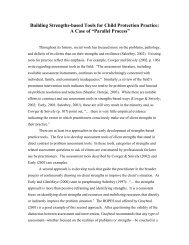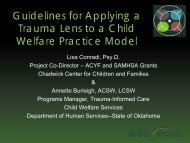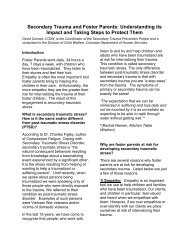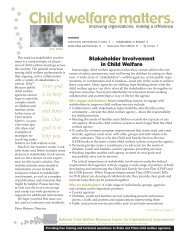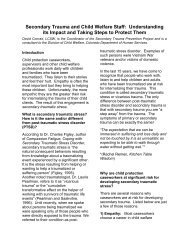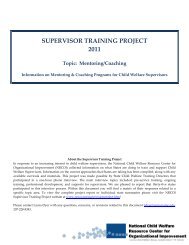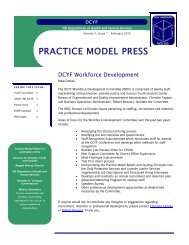Building a Model and Framework for Child Welfare Supervision
Building a Model and Framework for Child Welfare Supervision
Building a Model and Framework for Child Welfare Supervision
Create successful ePaper yourself
Turn your PDF publications into a flip-book with our unique Google optimized e-Paper software.
Element 7<br />
Support supervisors in their roles as unit leaders <strong>and</strong> change<br />
agents.<br />
The emerging model <strong>for</strong> child welfare supervision also empowers supervisors to influence the<br />
agency as leaders <strong>and</strong> change agents (Cearly 2004; <strong>Child</strong>ren’s Rights & NCYL 2007; Dawson<br />
1998; NRCOI 2007; Shanock & Eisenberger 2006). When an organization’s practices <strong>and</strong>/or<br />
policies exclude supervisors from such activities, it clearly conveys a de-valuing of their pivotal role<br />
in the organization, their expertise, <strong>and</strong> their firsth<strong>and</strong> underst<strong>and</strong>ing of frontline practice issues <strong>and</strong><br />
practitioners’ <strong>and</strong> clients’ needs <strong>and</strong> concerns. There<strong>for</strong>e, the model necessarily incorporates<br />
• systematically including them in quality assurance activities, program evaluation, <strong>and</strong><br />
redesign of in<strong>for</strong>mation systems, <strong>for</strong>ms, <strong>and</strong> procedures;<br />
• training supervisors first <strong>for</strong> all policy <strong>and</strong> practice changes;<br />
• involving supervisors in the recruitment, selection, <strong>and</strong> training of new frontline<br />
practitioners (NRCOI 2007; CO DHS 1994; Str<strong>and</strong> 2008; Dickinson 2007); <strong>and</strong><br />
• frequently recognizing supervisors’ own <strong>and</strong> their units’ accomplishments.<br />
The nature <strong>and</strong> degree of supervisors’ involvement in the activities Supervisors have their<br />
identified above will vary among organizations, ranging, <strong>for</strong> example, thumbs on the pulse of<br />
from having supervisors directly provide training to frontline<br />
practice. Supervisors have<br />
practitioners to having supervisors create <strong>and</strong> implement a training<br />
to take a leadership role—<br />
plan with each practitioner in their unit (CO DHS 1994). However,<br />
through supervisors’ experiences with frontline practitioners, they they have a key role in<br />
have a front row view of practice situations in which agency policy is shaping <strong>and</strong> developing<br />
not having the desired effects as well as situations <strong>for</strong> which<br />
policies <strong>and</strong> practices. –<br />
appropriate policy has not yet been developed. There<strong>for</strong>e,<br />
Administrator<br />
organizationally, supervisors are in a critical position to identify<br />
policy issues <strong>and</strong> needs <strong>and</strong> propose <strong>and</strong> advocate <strong>for</strong> relevant changes. Similarly, supervisors<br />
directly observe the degree to which agency systems, such as in<strong>for</strong>mation systems, <strong>and</strong> tools, such<br />
as <strong>for</strong>ms, either facilitate or undermine efficient <strong>and</strong> effective service delivery.<br />
Agency administrators <strong>and</strong> managers must recognize that supervisors’ observations, knowledge,<br />
<strong>and</strong> expertise are valuable resources upon which child welfare agencies can systematically draw in<br />
evaluating programs, policies, <strong>and</strong> infrastructure <strong>and</strong> in developing <strong>and</strong> implementing necessary<br />
changes. Kadushin <strong>and</strong> Harkness stress, “The supervisor is in a strategic position to act as a change<br />
agent. St<strong>and</strong>ing between administration <strong>and</strong> the workers, he or she can actively influence<br />
administration to make changes <strong>and</strong> influence workers to accept them” (2002:75)<br />
22




